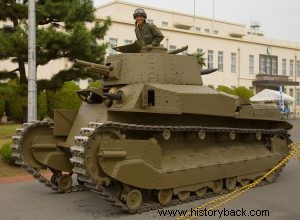
The Japanese army showed relatively late interest in tanks. From the mid-1920s, he began the effort to develop domestic tanks. Tanks were considered infantry support weapons, according to French doctrine.
The Yasuoka Group it had the 3rd Tank Regiment with four tank companies (26 Type 89, 4 Type 97 Chi Ha, 4 Type 97 Te Ke light tanks, 7 Type 94 tanks), the 4th Tank Regiment (35 Type 95 Ha Go, 8 Type 89, 3 Type 34), the 64th Infantry Regiment , the 2/28th Infantry Battalion and an artillery squadron . Lieutenant General Masuomi Yasuoka was put in charge who was considered an expert in armored fighting.
The Japanese had decided to attack from two directions with the goal of capturing Hill 721. The Japanese would launch two convergent attacks. The Yasuoka Complex was the southern leg of the helagra and was aimed at clearing the west bank of the Halha River and advancing beyond the east bank.
The northern Japanese Helagra captured Hill 721. Soon, however, Soviet artillery inflicted serious blows on it. When he did not accept the counterattack of strong Soviet forces, he retreated. South Lt. Gen. Yasuoka moved to cover his right with the 2/28th Battalion and assigned his armor to pursue the enemy who he thought was retreating. Because of this error, the cohesion of his complex was broken due to the different speed of the elements that made it up.
Also due to radio shortages the Japanese elements could not coordinate.
On the night of July 2-3, 1939 the units of the complex rushed out uncoordinated. In the following days some Japanese units advanced relatively smoothly until July 5 when they began constantly encounter stronger resistance. Other divisions met the enemy earlier and then stopped.
At noon on July 3, the Soviets attacked with infantry and tanks, supported by artillery, against the 2/28th Battalion. The Japanese suffered heavy losses. With their right flank exposed, the group's armor launched isolated, uncoordinated attacks inflicting casualties. The short-barreled 57 mm guns. of the Type 89 and Type 97 tanks and those of the 37 mm. of the Type 95, proved ineffective against Soviet tanks, while their armor proved to be completely inadequate.
It is noted that the maximum armor of the best armored Japanese tank (Type 97) was 25 mm thick. Yosuoka ordered the 3rd Tank Regiment to attack a fortified Soviet position. Regimental commander Colonel Yoshimaru's Type 97 tank became "stuck" in Soviet barbed wire when it became entangled in its drive wheel.
The stalled Japanese tank came under heavy fire from Soviet BT-7 tanks and anti-tank guns. The colonel's chariot was blown up. Most of the other tanks of the 3rd Tank Regiment had a similar fate.
On the contrary the 4th Tank Regiment of colonel Tamada succeeded better, managing to surprise, with a night attack, the Soviets and penetrate up to the Soviet artillery positions neutralizing at least one squadron. Despite orders to continue the attack Tamada, thinking wisely, preferred to withdraw the 4th Regiment as there was no link with the rest of the Japanese forces.
In any case the defeat of the 2/28th Battalion sealed the fate of the group's attack as the threat to its right flank did not allow the attack to continue. The defeat resulted in Yasuoka's impeachment on July 9, 1939. He was placed in charge of a replacement division until 1941 when he resigned from the army. In 1942, however, he was appointed military commander in Surabaya, Java. He behaved with cruelty and after the surrender of Japan he was tried by the Dutch and executed as a war criminal.
The Japanese tanks
The Type 97 Chi Ha medium tank it was the most modern and powerful in the Japanese arsenal at the time. It carried a short-barreled 75 mm gun and two machine guns. Its maximum armor was 25 mm thick. It reached a maximum speed of 38 km per hour on the road. It had a weight of 15.5 tons and a crew of four.
The Type 89 I Go it was the main Japanese tank before the introduction of the Type 97. It weighed about 15 tons, had a maximum armor of only 17 mm. crew of four and was armed with a short-barreled 57mm gun. and two machine guns. Its maximum road speed reached 26 km per hour.
The Type 95 Ha Go light tank it weighed 8 tons and had a crew of three. Its maximum armor was only 12 mm thick. It was armed with a 37 mm gun. and with two machine guns. It reached a maximum speed of 45 km per hour on the road.
Similar was the Type 97 Te K light tank e. The tank weighed only 5 tons and was armed with a 37mm cannon. and a machine gun. The maximum thickness of its armor reached 16 mm. It had a crew of two and developed a maximum speed of 42 km per hour.
Finally the type 94 armatid had a weight of 3.5 tons, maximum armor of 12 mm. crew of two and was armed with only one 6.5mm machine gun. It developed a maximum speed of 40 km per hour.

Japanese tank and infantry in Manchuria.

Japanese Type 97 battle tank.

Japanese tank Type 89.

Japanese Type 95 Ha Go light tank.

Japanese Type Te Ke light tank.

Japanese Type 94 chariot.
